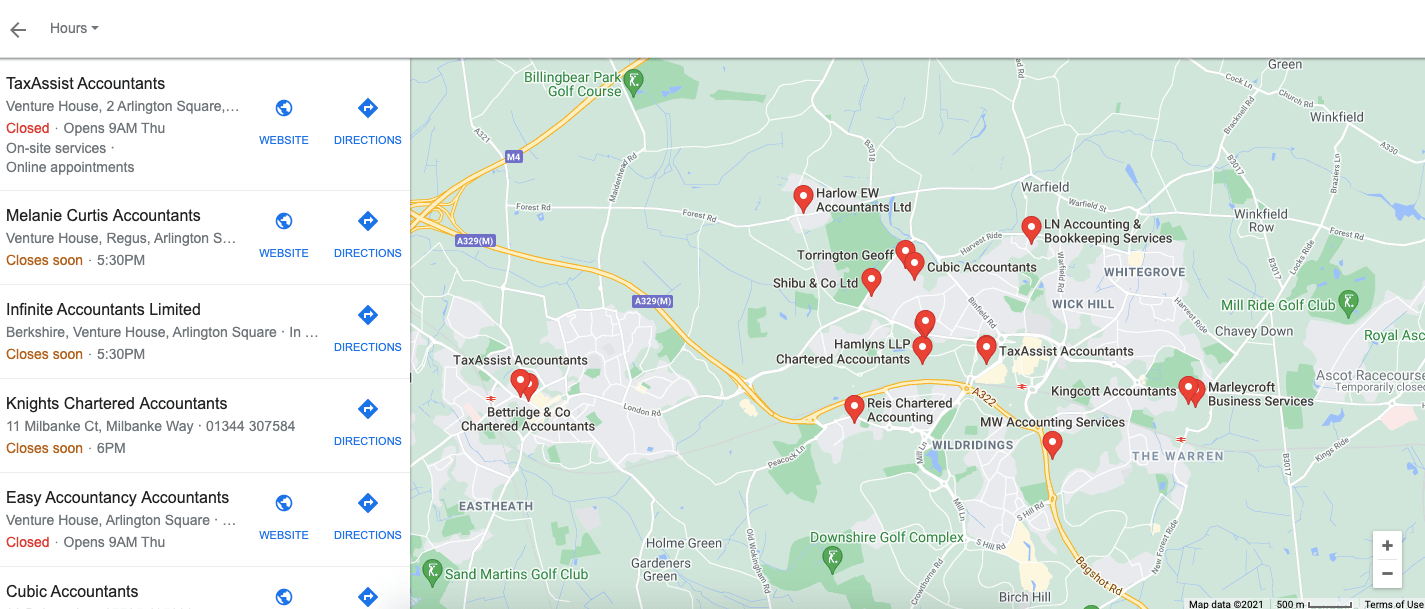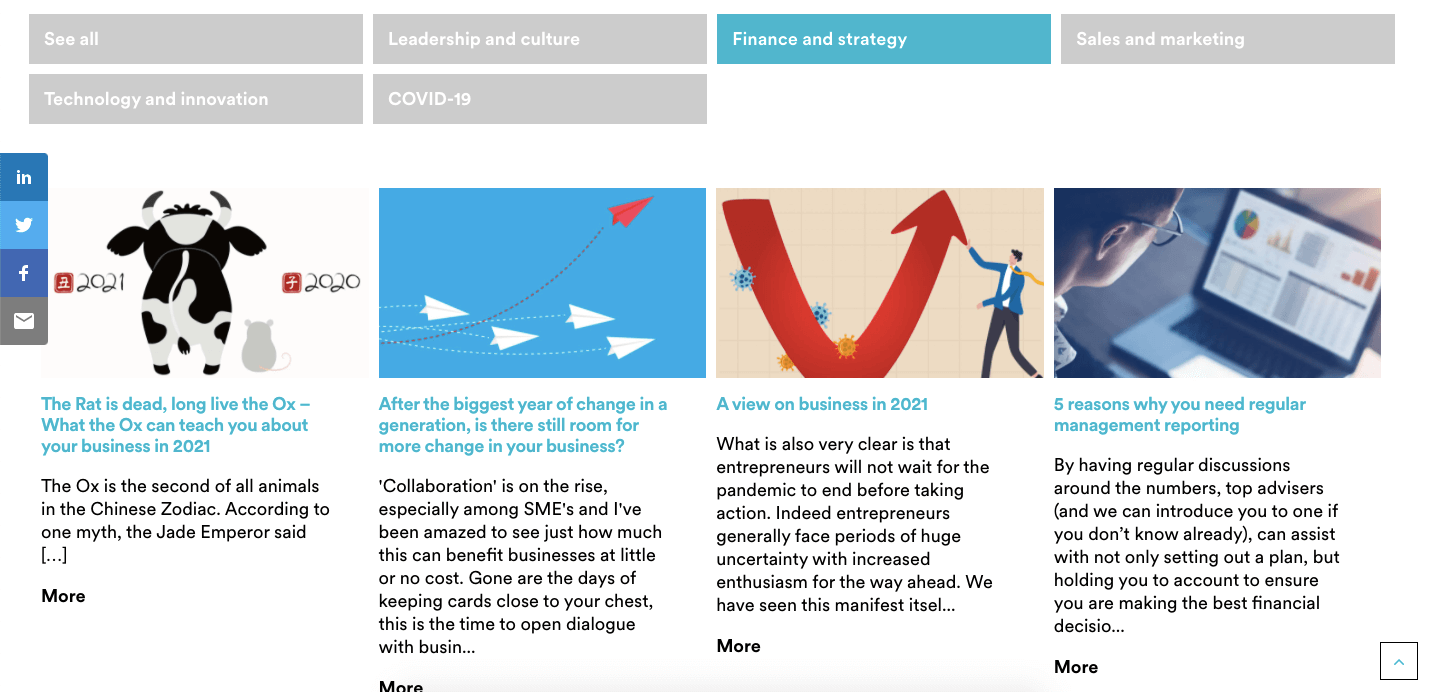In today’s digital age, the internet is everything. If your accounting firm isn’t online, you will be missing out on a lot (and we mean a lot) of opportunities. And with 68% of consumers agreeing that their expectations for businesses’ digital capabilities have increased as a result of COVID-19, to be successful you need to not only have an online presence – you really need to nail it, too.
The world of digital can be daunting: especially for those who have always stuck with traditional channels. But times are changing, and your firm needs to, too. So, here are 5 tips to help you master marketing for your accounting firm in today’s digital age.
1. Get to grips with your market
Whether it’s digital or offline, when it comes to marketing for accountants, the first step of any successful strategy is always research. This should be split into 4 key categories: business, customer, competitor and broader market analysis.
Business analysis
Always start with your business analysis, as before you try to understand anything else, you need to first get to grips with exactly who your firm is and why you exist. To effectively complete this analysis, think about answering the following:
- What is the purpose behind your accounting firm?
- What problem are you helping to solve? How is your solution better than your competitors?
- Who is behind the business? Do you have a communication plan involving all key stakeholders?
- What are your organisational values? Are they documented?
- What are your strengths and weaknesses? How can you leverage or overcome them?
- Can you see opportunities or threats? Is there anything you are doing better than anyone else in the industry?
- What is your firm’s vision?
Customer research
Once you’ve completed an in-depth analysis of your business, you can move on to your clients. You need to understand their pain points, their wants and needs, any common objections you may have to face and most importantly, how your services will benefit them. Ultimately, it’s all about being able to present your accounting firm as a solution – one that works better than any other on the market. You should also consider:
- Demographic information
- Where they are most active (these are the channels you should prioritise)
- Their preferred method of communication
- Any other information you feel will help you to build more meaningful relationships

Remember: to attract clients (and keep them) you need to treat them as human beings, not just another business opportunity.
Competitor analysis
Conducting a competitor analysis will not only help you identify niches in your market, but will also provide an invaluable learning opportunity. It will allow you to see whether there are areas that your competitors are neglecting, any underperforming areas you feel your firm could improve upon and any mistakes to avoid and successes to learn from.
Broader market analysis
Once you have a solid understanding of the above, it is time to look at the bigger picture. When analysing your market, it is best to use PESTLE (Political, Economic, Social, Technological, Legal, Environmental) to evaluate external factors that may impact your business. This could include anything from Tax rates changes to new reporting requirements.
2. Master your website
Your website is often the first port of call for both new and existing customers – so you really need to nail it. Just as the eyes are the window to the soul, your website is the doorway to your accounting firm. This is a place where first impressions count and mistakes are rarely forgiven: for example, did you know that website conversion rates drop by an average of 4.42% per second once the page-load time reaches five seconds? Or that it takes an average of just 0.05 seconds for a user to decide whether they want to stay on your site with 94% of these first impressions being design-related? So, yeah, it’s a big deal.
But fear not, we have some top tips to help your site achieve results:
- Keep things predictable; if your audience is unable to navigate your site effectively, they will leave
- Create content for your clients (not yourself); your website should be designed with the end-user in mind, which means having an awareness of what they want to see. For example, 86% of B2B buyers are interested in information about products and services, 62% want to see contact information and 52% expect to see an “about us” section
- Use visuals to help break up text-heavy pages and keep your audience engaged

Another key consideration is mobile optimisation. With over half of all web traffic now coming from mobile devices, if you fail to make your site mobile-friendly, you will be missing out on a lot of opportunities. To put things into perspective, 52% of consumers say that a poor mobile experience will make them less likely to engage with a company – a number that is only set to increase as mobile devices become more popular.
Some areas that need to be addressed to help you master mobile UX, include:
- Page layout
- Site speed
- Font size
- Responsive design
For more UX design tips, be sure to check out Dan’s latest YouTube video:
3. Get seen with SEO
SEO (or search engine optimisation) is the process of optimising both on and off-page aspects of your website to help improve your ranking for key terms in the search results. To discover more about SEO and learn how to create a strategy that puts your accounting firm at the top of the search engine results, be sure to check out our ultimate guide to SEO here. In the meantime, here are a few helpful tips to get you started.
On-page SEO
As the name suggests, on-page (or on-site) SEO involves optimising the content on your site for both search engines and users. This involves things like optimising title tags, publishing unique, keyword-rich content, adding internal links and optimising your URLs.
Off-page SEO
Unlike on-page SEO, many of the ranking factors for off-page (also known as off-site) SEO rely on the help of others. They include things such as inbound links, social media presence, brand mentions and influencer marketing. All of which have the goal of improving the relevancy, authority and trustworthiness of your site.
Local SEO
Local SEO involves targeting location-focused search queries in the hopes of attracting local clientele. In the past two years “near me” searches have grown by more than 200%, so it’s certainly worth putting your accounting firm on the map. And we mean this quite literally: with the help of Google My Business you can ensure your accounting firm is listed when a user enters a location-based search query, such as “Accounting firms in Berkshire”.

Along with Google My Business signals, other local SEO ranking factors include:
- Link signals (for example, inbound links and domain authority)
- On-page factors
- Reviews
- Behavioural signals (for example, click-through rates and clicks to call)
- Social media engagement
4. Captivate with content
Content is king. It’s great for building relationships, increasing traffic, driving conversions and establishing authority (to name just a few) and it has a killer ROI: costing 62% less than traditional marketing but generating up to 3x more leads per dollar.
When it comes to content marketing, bigger is always better. The accounting market is crowded; to stand out you need to be bold. Whilst long-form content, such as guides and ebooks are a great way to extend your reach, share your expertise and build powerful relationships that over time, will develop into business opportunities, it often takes a while to produce. So, in the meantime, here are a few content ideas to keep you busy.
Blogging
Publishing regular blog posts is a great way to drive organic traffic to your website and improve your SEO. In fact, according to Forbes, websites with regularly updated blogs have up to 434% more indexed pages and receive 97% more inbound links. But, with WordPress users alone publishing over 70 million new posts each month, if you want to stand out, you need to think big.

Some tips to help get your accounting blog noticed include:
- Always write with your target audience in mind; if your content isn’t relevant, they won’t want to read it
- Conduct keyword research to help identify relevant topics
- Focus on quality over quantity; articles with more than 3,000 words receive up to 3x more traffic, 4x more shares, and 3.5x more backlinks than shorter posts
- Listicles (content presented in the form of a list) get up to 2x more shares than other types of blog posts
Podcasting
In recent years, podcasting has become a huge trend in both B2C and B2B markets. They are a great way to build relationships with your audience whilst helping to increase brand awareness, drive traffic to your site, establish authority and improve conversion rates. Some examples of popular podcasts within the accounting industry include Accounting Best Practices with Steve Bragg, Accounting Today Podcast, AccountingWEB Podcast, The Accounting Success Podcast and The Big 4 Accounting Firms Podcast.
For help getting started, be sure to check out our podcasting blog post for all the tips and tricks needed to make your accounting firm a hit.
Video
It’s memorable, engaging and highly cost-effective. It’s no wonder more than 80% of businesses now use video marketing within their digital strategy. And here’s a few reasons why you should, too:
- It’s great for SEO (with pages including video being up to 50x more likely to rank on the first page of the search results)
- 87% of video marketers say it has increased traffic to their website
- Over 90% of internet users regularly share video content
- 84% of consumers say they are more likely to work with a brand after watching an explainer video
- On average, explainer videos return 8x the original investment
Infographics
Engaging, informative, memorable and most importantly, shareable. Infographics are a fantastic way to educate your audience and maximise the reach of your content. And to show you just how great they are, here is an infographic by Visually to explain the benefits:
5. Choose your channels
Once you’ve created your content, you need to decide which channels to prioritise when sharing it. Of course, we’ve already touched upon the importance of your website and SEO, but there are still many digital channels left unexplored – two of which will be discussed below.
Email marketing
Free. Efficient. Easy to use. There really is no excuse for any accounting firm not to be using email marketing – other than not knowing how. We are here to fix that. For an in-depth guide to email marketing, check out our latest resource here, but if you are looking for an overview, here are some tips to get you heading in the right direction:
- Embrace automation
- Make use of personalisation
- Ensure your subject lines are engaging, succinct and enticing
- Segment your audience
- Always monitor your performance
Social media
Whilst traditionally considered to be primarily for the B2C market, more and more B2B businesses are now embracing social media and the benefits it offers. From generating leads and driving traffic to your website to building your employer brand and forming more meaningful relationships, social media can help your accounting firm in more ways than you might think.

We’ve covered the must-know secrets of social media marketing in our recent blog post, but to summarise some of the key platforms:
- LinkedIn: the most popular B2B social networking site, LinkedIn now accounts for more than 50% of all social traffic to B2B blogs and websites. Generating up to 3x more conversions than any other platforms and scoring 80% of B2B social media leads, it is certainly the network to prioritise.
- Facebook: the largest social media platform, Facebook is certainly not short of opportunities. With the ability to publish highly targeted ads at the touch of a button and access a range of helpful audience insights, it’s no wonder that Facebook remains one of the top social channels for B2B marketers.
- Instagram: many B2B marketers are still getting to grips with Instagram, but there is no doubt that it has arrived and it’s here to stay. Enabling businesses to share more creative and engaging content, Instagram helps bridge the gap between B2B and B2C marketing and enables consumers to feel more connected to brands.
For more helpful tips and tricks on how to master marketing for accounting firms, be sure to check out our ultimate guide to marketing for accountants here. Alternatively, head over to our digital marketing for accounting firms page to check out relevant case studies and discover more about how our agency can help your firm grow.





